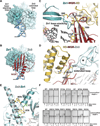Structural basis for DNA damage-dependent poly(ADP-ribosyl)ation by human PARP-1
- PMID: 22582261
- PMCID: PMC3532513
- DOI: 10.1126/science.1216338
Structural basis for DNA damage-dependent poly(ADP-ribosyl)ation by human PARP-1
Abstract
Poly(ADP-ribose) polymerase-1 (PARP-1) (ADP, adenosine diphosphate) has a modular domain architecture that couples DNA damage detection to poly(ADP-ribosyl)ation activity through a poorly understood mechanism. Here, we report the crystal structure of a DNA double-strand break in complex with human PARP-1 domains essential for activation (Zn1, Zn3, WGR-CAT). PARP-1 engages DNA as a monomer, and the interaction with DNA damage organizes PARP-1 domains into a collapsed conformation that can explain the strong preference for automodification. The Zn1, Zn3, and WGR domains collectively bind to DNA, forming a network of interdomain contacts that links the DNA damage interface to the catalytic domain (CAT). The DNA damage-induced conformation of PARP-1 results in structural distortions that destabilize the CAT. Our results suggest that an increase in CAT protein dynamics underlies the DNA-dependent activation mechanism of PARP-1.
Figures




Comment in
-
Structural biology. PARP-1 activation--bringing the pieces together.Science. 2012 May 11;336(6082):678-9. doi: 10.1126/science.1221870. Science. 2012. PMID: 22582250 No abstract available.
-
Basic research: A close look at PARP-1.Nat Rev Clin Oncol. 2012 May 29;9(7):369. doi: 10.1038/nrclinonc.2012.93. Nat Rev Clin Oncol. 2012. PMID: 22641365 No abstract available.
References
-
- Fong PC, et al. N Engl J Med. 2009 Jul 9;361:123. - PubMed
Publication types
MeSH terms
Substances
Associated data
- Actions
Grants and funding
LinkOut - more resources
Full Text Sources
Other Literature Sources
Molecular Biology Databases
Miscellaneous

